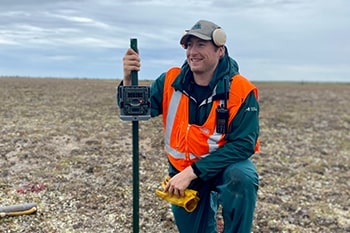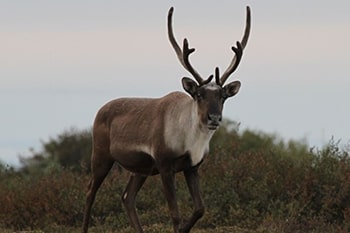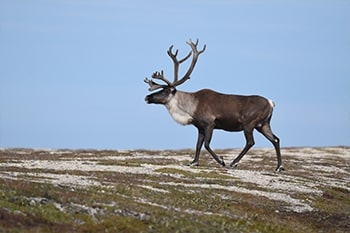Russell Turner
Wapusk National Park
When your work focuses on the flora and fauna that thrive in Wapusk National Park, it makes for some fascinating and eventful field trips! That’s the case for Russell Turner, Ecosystem Scientist with Parks Canada, one of the lucky researchers whose job regularly takes him into the northern Manitoba park for research and monitoring work.

“The main thing I remember about going into Wapusk for the first time is how fast the landscape in the park changes. As we were flying in the helicopter, you came across almost every landscape that exists in Wapusk,” Russell recalled. “The landscape changed from no trees, to treed, to bog, to wetland, to peat plateaus, to a huge river system surrounded by trees, back to peat plateau. People tried to describe the landscape to me beforehand but it just doesn’t make sense until you experience it for yourself.”
Recognized globally for its significant biodiversity, Wapusk National Park is home to an abundance of plant and animal species, including fox, wolves, polar bears, caribou, wolverine, hares and hundreds of bird species.
On one of his early excursions into the park, Russell remembered coming across a large gathering of approximately 700 caribou.

“It was my first sighting of caribou in the park and I was just so excited to see this large tander (grouping of caribou). It was also the first time in many years that park staff had seen such a large gathering. The next day we saw a grouping of about 1,000 individuals, which was amazing,” Russell said.
These were significant sightings for both Russell and Parks Canada, as the caribou populations in Canada are in decline. Caribou are an essential part of the northern Manitoba ecosystem. They play a vital role in sustaining northern communities and Indigenous culture. Parks Canada is actively working with the many communities and organizations with interest in the caribou to gain a better understanding of the status of caribou herds that utilize Wapusk. The sighting of the two large groups inspired Russell and colleagues to reach out to park researchers, past and present, who may have also taken photographs of caribou in the park over the last number of decades. By gathering these photos, it is a way to estimate and understand the caribou population in Wapusk over time.
In his role with Parks Canada, Russell has been instrumental in planning a series of workshops over the last two years aimed at weaving together different ways to protect and better understand the caribou population. The multi-day events brought together Indigenous communities, various levels of government, academic researchers and local communities as a structured way to share Indigenous Knowledge and western science perspectives related to caribou in Wapusk National Park and the Greater Wapusk Ecosystem. The workshops focused on discussing collaborative actions to support biological and culturally appropriate conservation methods, and ways in which we can collectively advance reconciliation through conservation.
One of the outcomes of the workshop was the establishment of a new collaborative project between Parks Canada, the University of Saskatchewan and the Manitoba Métis Federation to set up trail cameras throughout Wapusk as a means to detect the distribution of caribou within its boundaries. And just this past summer, a team comprised of representatives from the three organizations headed into the park together to successfully deploy a total of 92 trail cameras in various distinct habitats throughout the park. Following the success of this project, the Parks Canada team in Churchill is keen to have other Indigenous communities and organizations participate in ongoing park monitoring and research projects.

“The work we’ve done with caribou via the workshops has resulted in strengthened relationships, increased trust, and a series of actions and recommendations for how Parks Canada can achieve its caribou conservation goals and improve the way it engages Indigenous partners on caribou research and monitoring,” Russell said.
Moving forward, he hopes to continue working with the various communities and organizations involved in the workshops to develop further strategies for effective caribou conservation in Wapusk.
- Date modified :